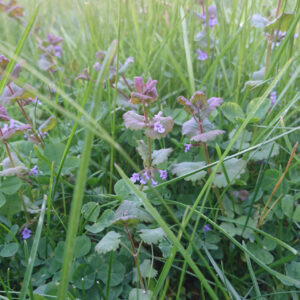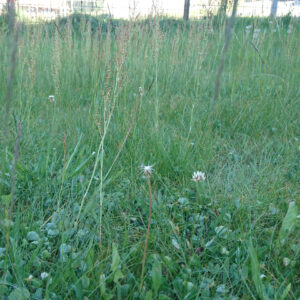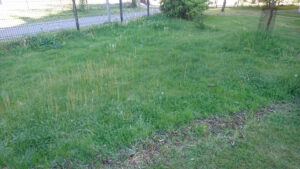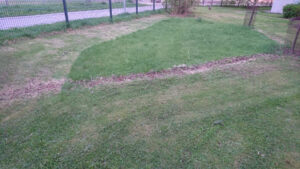Easy Meadow – Turning Useless Lawns into Meadows in Housing Cooperatives
The Basic Instructions for an Easy Meadow:
1. Stop mowing the lawn.
2. Wait and see what emerges.
3. Admire the blossom.
This is how easy meadowing can be at its best. Many old lawns already host meadow flowers, so reducing mowing to 1–2 times a year may be all you need to enable a meadow for it to grow by itself. The idea of an easy meadow is to make use of the species already growing on the site, which makes meadowing easy.
How to make an easy meadow
A suitable place for a meadow is a well-lit area where the lawn is not used for walking, sunbathing, or playing games. Some flowers can also survive in part-sun. Doubtful neighbours may be appeased if the meadow is not close to balconies or children’s play areas.You can start with just a small area and expand it later. Areas where there are already flowers growing amidst the grass, or places where it’s difficult for grasses to thrive, such as dry or nutrient-poor areas are particularly favourable. If there are trees in the courtyard, consider establishing a meadow under their canopies, so that you don’t risk damaging their roots while mowing.
To get an official approval for the meadow, the most straightforward thing to do is often to make a suggestion to the housing cooperative board (taloyhtiön hallitus), the property manager (isännöitsijä), or a residents’ committee (asukastoimikunta), and they can decide how to proceed. Usually the board of the cooperative can decide about establishing a meadow without a vote from the shareholders. It may still be a good idea to take it to a cooperative meeting for discussion, so that neighbours get a chance to ask questions. Taking the matter to a cooperative meeting is also a good idea if the board is hesitant or declines altogether. You may also discuss the meadow project with your neighbours upon random encounters. This way you may gain support for your suggestion and help for the establishing work. It’s more fun together! Our model letter for the housing cooperative board is only in Finnish, but if you need help with that, please ask us!
The meadow should be clearly marked, so that the maintenance company remembers not to mow it and neighbours don’t trample it unwittingly. [Check out our instructions for maintenance companies.] A sufficient mark for the area might be poles or sticks on the border, bark chip, or a sign or two. Remember to take the “before” picture for a “before and after” comparison!
Stop mowing the grass in the meadow area and wait patiently to see what comes up. Many old lawns already host plenty of flowering species.
If flowers indeed blossom among the grasses, sufficient maintenance of the meadow is 1–2 times during the summer. Mowing is best done towards the end of summer, after the flowers have spread their seeds. If you want, you can also mow it once during the growing season (this enables low-growing flowers to have their turn). While waiting, admire the flowers and observe the butterflies and the birds! If no flowers appear over the summer, establishing a meadow in your courtyard requires some more work. See below for instructions for establishing a new meadow.
Please tell us how it went! We’d love to hear your experience of the different phases of the process! We are also collecting a picture gallery of the easy meadow projects in different housing companies, so photos are most welcome, too. If you give us permission, we’d be pleased to put “before and after” photos on this website. Tell your friends about your meadow and these instructions to make it easy for them to establish an easy meadow in their courtyard as well!
What is an easy meadow?
Iisi niitty on luonnonkukka-alue, jonka perustamisen ja hoidon ytimessä on, ettei sille tehdä An easy meadow is a wildflower zone with minimal human management; you don’t really do much of anything to do besides enjoy it. This way the flower seeds, mycorrhizal fungi and microbes that reside in the soil – and that are already adapted to that particular growing environment – get a chance to pick up on where they left off earlier. When the soil is not tilled and the roots not severed, the stored carbon won’t escape to the atmosphere, and you don’t have to start from scratch in establishing a community of species. An easy meadow doesn’t have to correspond to the ecological concept of a meadow as a habitat type – it’s enough that it provides food and shelter for pollinators, butterflies and other little creatures both above and below the surface.
Please help me to get started!
If you’re unsure where an easy meadow should be established, we can do our best to help you choose a spot. Within the capital region we’re happy to come and have a look at your yard! People living elsewhere in Finland can send us pictures of their courtyard and information of its different uses, which parts are in the sun or in the shade, and where it’s moist or dry. It’s also useful to mention if there are already flowers growing among the grasses. It is good to have both a general overview picture (i.e. taken from a balcony), and more detailed pictures of the lawn areas.
The Easy Meadows project is run by volunteers, so our capacity to help out in establishing meadows is limited. If there’s much demand, we may have to decline.
Instructions for the maintenance company
These days it’s common for housing cooperatives to have their courtyards maintained by a maintenance company. In our experience, the needs of a housing company for an easy meadow are quite simple. In short: the area has to be clearly marked and the mowing time (or times) must be communicated to the company sufficiently early. It’s best to agree on the maintenance as early and as clearly as possible with whomever takes care of the courtyard. We’ve also written a more detailed set of instructions for dealing with the housing company, which for now is only available in Finnish. Please ask us for help if you need some (iisiniitty [at] maanystavat.fi)!
FAQ: How to convince your neighbour
- Why? → There are many benefits to an Easy Meadow. First of all, flowers and butterflies are much nicer to look at than grass scorched in the sun. As maintenance is reduced, less carbon is emitted, and it saves some trouble and money. The meadow alleviates the food and housing issues that bees and other little neighbours face in urban areas. An Easy Meadow thus helps both the climate and biodiversity.
- But this may help ticks, too! → You should establish the Easy Meadow in a place that’s not used much for walking, sunbathing, playing ball games and the like. On a large lawn one could start with converting the least used areas. Another possible approach would be to make paths in the middle of the meadow, or even a space to hang out. Also, even a mown lawn can have ticks on it, so regular tick inspections are a good idea regardless of how the courtyard is managed.
- Does a meadow attract wasps? → The meadow may attract wasps, but in a way that’s part of the idea – wasps are pollinators, too! They also feed their larvae with pest insects. The meadow shouldn’t be established right next to a children’s play area or under balconies. Parents are responsible for making sure their kids play safely and don’t disturb wasps if there are some. A single sting is rarely dangerous.
- What about weeds? → Many plants that are often labeled weeds, such as dandelions, are actually quite pretty, and also very helpful to pollinators and the rest of the ecosystem. They deserve a rehabilitation! In case the emerging meadow starts to look unpleasant to your eye and you start to regret the whole thing, you can either restore the lawn by just mowing more often again, or then establish a “proper” meadow where you can choose the species yourself.
- Does it look untidy? → Well, it’s a matter of taste. But we encourage you to contemplate on where the need for a tidy and short-trimmed lawn arises from, unless the area has such use that requires a short lawn. The natural beauty of blooming flowers and butterflies can be aesthetically at least as pleasant a sight!
- But surely it’s expensive and laborious! → Easy meadows are both easy and cheap. On many lawns, it’s enough to let the grass grow and see what comes up. This saves work and money compared to the maintenance of a lawn. On the other hand, if there aren’t any flowering species on the spot, establishing a new, “proper” meadow requires some more work and money. Even so, once it’s there, it’s a cheap and easy solution for your courtyard.
- We don’t have any room for this! → An easy meadow can be established on even a very small strip of grass, or the bank of a ditch. Even a few square meters of wildflowers are helpful for pollinators.
- What’s a useless lawn? → A useless lawn is a patch of managed lawn that doesn’t have any proper use as a lawn. If it’s not used for walking, hanging out or playing, it’s better to turn it into an easy meadow. Such spots where grass doesn’t really flourish or requires a lot of work, like dry, sandy or infertile soils, are particularly good for this, and might be a much better habitat for meadow flowers.
- I’m convinced! When is my meadow ready? → This depends on the place and what’s already there. If many flowering species are present to begin with, a nice meadow can emerge the very first summer. Typically the variety of species develops over the years, and in some places it may take a few years before it starts to get more diverse.
Instructions for a “proper” new meadow
Instructions on establishing a meadow in your courtyard can be found in many places. In such instructions, “meadow” typically refers to a certain type of habitat. The instructions contain a reworking of the land to be poor in nutrients, and sowing of meadow flower seeds. Establishing such a “proper” meadow means more costs and work than an easy meadow. A “proper” meadow can be a good choice if you want your meadow to host some specific flower species, such as endangered meadow flower species.
- https://www.rhs.org.uk/lawns/creating-wildflower-meadows
- https://friendsoftheearth.uk/nature/how-make-wildflower-meadow
Tip: Sandbox sand is a suitable choice for sand. Flower species native to Finland can be bought, for instance Suomen Niittysiemen sells seed mixtures. You can also collect seeds yourself! If you do, make sure you don’t collect the seeds of invasive alien species (like the garden lupin or the Himalayan balsam; see https://vieraslajit.fi/ for more) and preferably not other alien species either. The seeds of protected and rare species are often best left alone so that they renew the existing population. Seed collection in nature conservation areas is prohibited.
Photo Gallery
More photos to be added over the growing season.
Panel discussion (in Finnish)
Contact
You can write to us at: iisiniitty@maanystavat.fi





